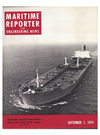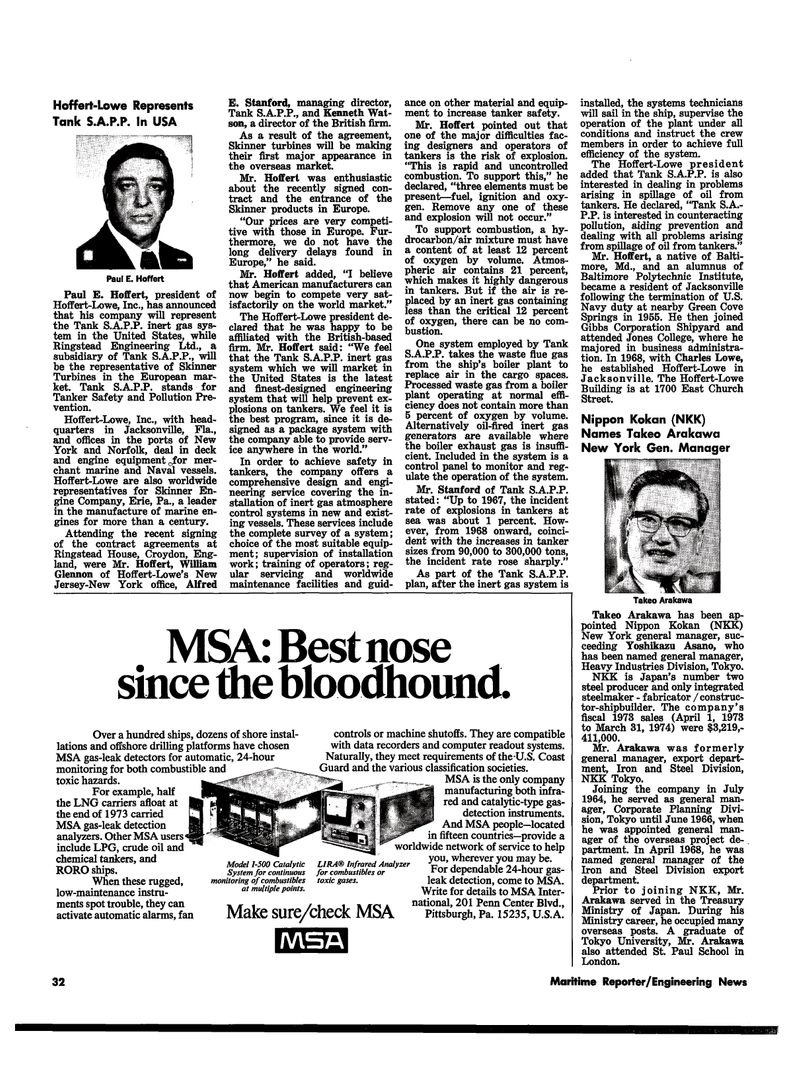
Page 28: of Maritime Reporter Magazine (September 1974)
Read this page in Pdf, Flash or Html5 edition of September 1974 Maritime Reporter Magazine
Hoffert-Lowe Represents
Tank S.A.P.P. In USA
Paul E. Hoffert
Paul E. Hoffert, president of
Hoffert-Lowe, Inc., has announced that his company will represent the Tank S.A.P.P. inert gas sys- tem in the United States, while
Ringstead Engineering Ltd., a subsidiary of Tank S.A.P.P., will be the representative of Skinner
Turbines in the European mar- ket. Tank S.A.P.P. stands for
Tanker Safety and Pollution Pre- vention.
Hoffert-Lowe, Inc., with head- quarters in Jacksonville, Fla., and offices in the ports of New
York and Norfolk, deal in deck and engine equipment Ofor mer- chant marine and Naval vessels.
Hoffert-Lowe are also worldwide representatives for Skinner En- gine Company, Erie, Pa., a leader in the manufacture of marine en- gines for more than a century.
Attending the recent signing of the contract agreements at
Ringstead House, Croydon, Eng- land, were Mr. Hoffert, William
Glennon of Hoffert-Lowe's New
Jersey-New York office, Alfred
E. Stanford, managing director,
Tank S.A.P.P., and Kenneth Wat- son, a director of the British firm.
As a result of the agreement,
Skinner turbines will be making their first major appearance in the overseas market.
Mr. Hoffert was enthusiastic about the recently signed con- tract and the entrance of the
Skinner products in Europe. "Our prices are very competi- tive with those in Europe. Fur- thermore, we do not have the long delivery delays found in
Europe," he said.
Mr. Hoffert added, "I believe that American manufacturers can now begin to compete very sat- isfactorily on the world market."
The Hoffert-Lowe president de- clared that he was happy to be affiliated with the British-based firm. Mr. Hoffert said: "We feel that the Tank S.A.P.P. inert gas system which we will market in the United States is the latest and finest-designed engineering system that will help prevent ex- plosions on tankers. We feel it is the best program, since it is de- signed as a package system with the company able to provide serv- ice anywhere in the world."
In order to achieve safety in tankers, the company offers a comprehensive design and engi- neering service covering the in- stallation of inert gas atmosphere control systems in new and exist- ing vessels. These services include the complete survey of a system; choice of the most suitable equip- ment; supervision of installation work; training of operators; reg- ular servicing and worldwide maintenance facilities and guid- ance on other material and equip- ment to increase tanker safety.
Mr. Hoffert pointed out that one of the major difficulties fac- ing designers and operators of tankers is the risk of explosion. "This is rapid and uncontrolled combustion. To support this," he declared, "three elements must be present—fuel, ignition and oxy- gen. Remove any one of these and explosion will not occur."
To support combustion, a hy- drocarbon/air mixture must have a content of at least 12 percent of oxygen by volume. Atmos- pheric air contains 21 percent, which makes it highly dangerous in tankers. But if the air is re- placed by an inert gas containing less than the critical 12 percent of oxygen, there can be no com- bustion.
One system employed by Tank
S.A.P.P. takes the waste flue gas from the ship's boiler plant to replace air in the cargo spaces.
Processed waste gas from a boiler plant operating at normal effi- ciency does not contain more than 5 percent of oxygen by volume.
Alternatively oil-fired inert gas generators are available where the boiler exhaust gas is insuffi- cient. Included in the system is a control panel to monitor and reg- ulate the operation of the system.
Mr. Stanford of Tank S.A.P.P. stated: "Up to 1967, the incident rate of explosions in tankers at sea was about 1 percent. How- ever, from 1968 onward, coinci- dent with the increases in tanker sizes from 90,000 to 300,000 tons, the incident rate rose sharply."
As part of the Tank S.A.P.P. plan, after the inert gas system is
MSA: Best nose since the bloodhound.
Over a hundred ships, dozens of shore instal- lations and offshore drilling platforms have chosen
MSA gas-leak detectors for automatic, 24-hour monitoring for both combustible and toxic hazards.
For example, half the LNG carriers afloat at the end of 1973 carried
MSA gas-leak detection analyzers. Other MSA users include LPG, crude oil and chemical tankers, and
RORO ships.
When these rugged, low-maintenance instru- ments spot trouble, they can activate automatic alarms, fan
Model 1-500 Catalytic
System for continuous monitoring of combustibles at multiple points.
Make sure/check MSA controls or machine shutoffs. They are compatible with data recorders and computer readout systems.
Naturally, they meet requirements of the-U.S. Coast
Guard and the various classification societies.
MSA is the only company manufacturing both infra- red and catalytic-type gas- detection instruments.
And MSA people—located in fifteen countries—provide a worldwide network of service to help r ,„ ^ , /• . . , you, wherever you may be.
LIRA® Infrared Analyzer V. , , , ,' _ . ,J for combustibles or For dependable 24-hour gas- leak detection, come to MSA.
Write for details to MSA Inter- national, 201 Penn Center Blvd.,
Pittsburgh, Pa. 15235, U.S.A. toxic gases. installed, the systems technicians will sail in the ship, supervise the operation of the plant under all conditions and instruct the crew members in order to achieve full efficiency of the system.
The Hoffert-Lowe president added that Tank S.A.P.P. is also interested in dealing in problems arising in spillage of oil from tankers. He declared, "Tank S.A.-
P.P. is interested in counteracting pollution, aiding prevention and dealing with all problems arising from spillage of oil from tankers."
Mr. Hoffert, a native of Balti- more, Md., and an alumnus of
Baltimore Polytechnic Institute, became a resident of Jacksonville following the termination of U.S.
Navy duty at nearby Green Cove
Springs in 1955. He then joined
Gibbs Corporation Shipyard and attended Jones College, where he majored in business administra- tion. In 1968, with Charles Lowe, he established Hoffert-Lowe in
Jacksonville. The Hoffert-Lowe
Building is at 1700 East Church
Street.
Nippon Kokan (NKK)
Names Takeo Arakawa
New York Gen. Manager
A/ISA
Takeo Arakawa
Takeo Arakawa has been ap- pointed Nippon Kokan (NKK)
New York general manager, suc- ceeding Yoshikazu Asano, who has been named general manager,
Heavy Industries Division, Tokyo.
NKK is Japan's number two steel producer and only integrated steelmaker - fabricator / construc- tor-shipbuilder. The company's fiscal 1973 sales (April 1, 1973 to March 31, 1974) were $3,219,- 411,000.
Mr. Arakawa was formerly general manager, export depart- ment, Iron and Steel Division,
NKK Tokyo.
Joining the company in July 1964, he served as general man- ager, Corporate Planning Divi- sion, Tokyo until June 1966, when he was appointed general man- ager of the overseas project de- partment. In April 1968, he was named general manager of the
Iron and Steel Division export department.
Prior to joining NKK, Mr.
Arakawa served in the Treasury
Ministry of Japan. During his
Ministry career, he occupied many overseas posts. A graduate of
Tokyo University, Mr. Arakawa also attended St. Paul School in
London. 60 Maritime Reporter/ Engineering News

 27
27

 29
29
